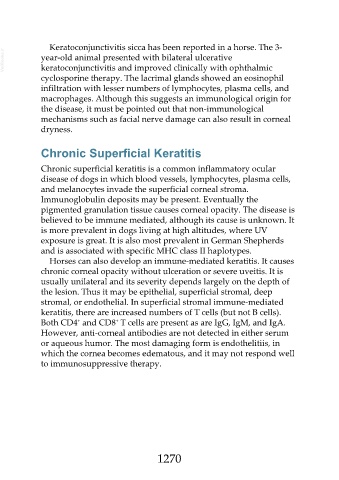Page 1270 - Veterinary Immunology, 10th Edition
P. 1270
Keratoconjunctivitis sicca has been reported in a horse. The 3-
VetBooks.ir year-old animal presented with bilateral ulcerative
keratoconjunctivitis and improved clinically with ophthalmic
cyclosporine therapy. The lacrimal glands showed an eosinophil
infiltration with lesser numbers of lymphocytes, plasma cells, and
macrophages. Although this suggests an immunological origin for
the disease, it must be pointed out that non-immunological
mechanisms such as facial nerve damage can also result in corneal
dryness.
Chronic Superficial Keratitis
Chronic superficial keratitis is a common inflammatory ocular
disease of dogs in which blood vessels, lymphocytes, plasma cells,
and melanocytes invade the superficial corneal stroma.
Immunoglobulin deposits may be present. Eventually the
pigmented granulation tissue causes corneal opacity. The disease is
believed to be immune mediated, although its cause is unknown. It
is more prevalent in dogs living at high altitudes, where UV
exposure is great. It is also most prevalent in German Shepherds
and is associated with specific MHC class II haplotypes.
Horses can also develop an immune-mediated keratitis. It causes
chronic corneal opacity without ulceration or severe uveitis. It is
usually unilateral and its severity depends largely on the depth of
the lesion. Thus it may be epithelial, superficial stromal, deep
stromal, or endothelial. In superficial stromal immune-mediated
keratitis, there are increased numbers of T cells (but not B cells).
+
+
Both CD4 and CD8 T cells are present as are IgG, IgM, and IgA.
However, anti-corneal antibodies are not detected in either serum
or aqueous humor. The most damaging form is endothelitiis, in
which the cornea becomes edematous, and it may not respond well
to immunosuppressive therapy.
1270

